Monitoring Sound and Its Perception during the Lockdown and De-Escalation of COVID-19 Pandemic: A Spanish Study
Abstract
1. Introduction
2. Pandemic and Noise
3. Materials and Methods
3.1. De-Escalation Phases in Spain
3.2. Questionnaires
3.3. Location of Respondents
3.4. Dataset
3.5. Recorded Noise
3.6. Noise Measurements
3.6.1. Overall
3.6.2. Loudness
4. Findings
4.1. Environmental Noise Results
4.2. Statistical Results from the Questionnaires
Sociodemographic Initial Analysis
4.3. Quality of Sound before the Lockdown
The Noise Annoyance before Lockdown Was Related to the Sociodemographic Data
4.4. Sound Quality during the Lockdown
4.5. Sound Quality during Phase 0 and Phase 1
5. Discussion
6. Conclusions
Author Contributions
Funding
Institutional Review Board Statement
Informed Consent Statement
Data Availability Statement
Acknowledgments
Conflicts of Interest
Appendix A
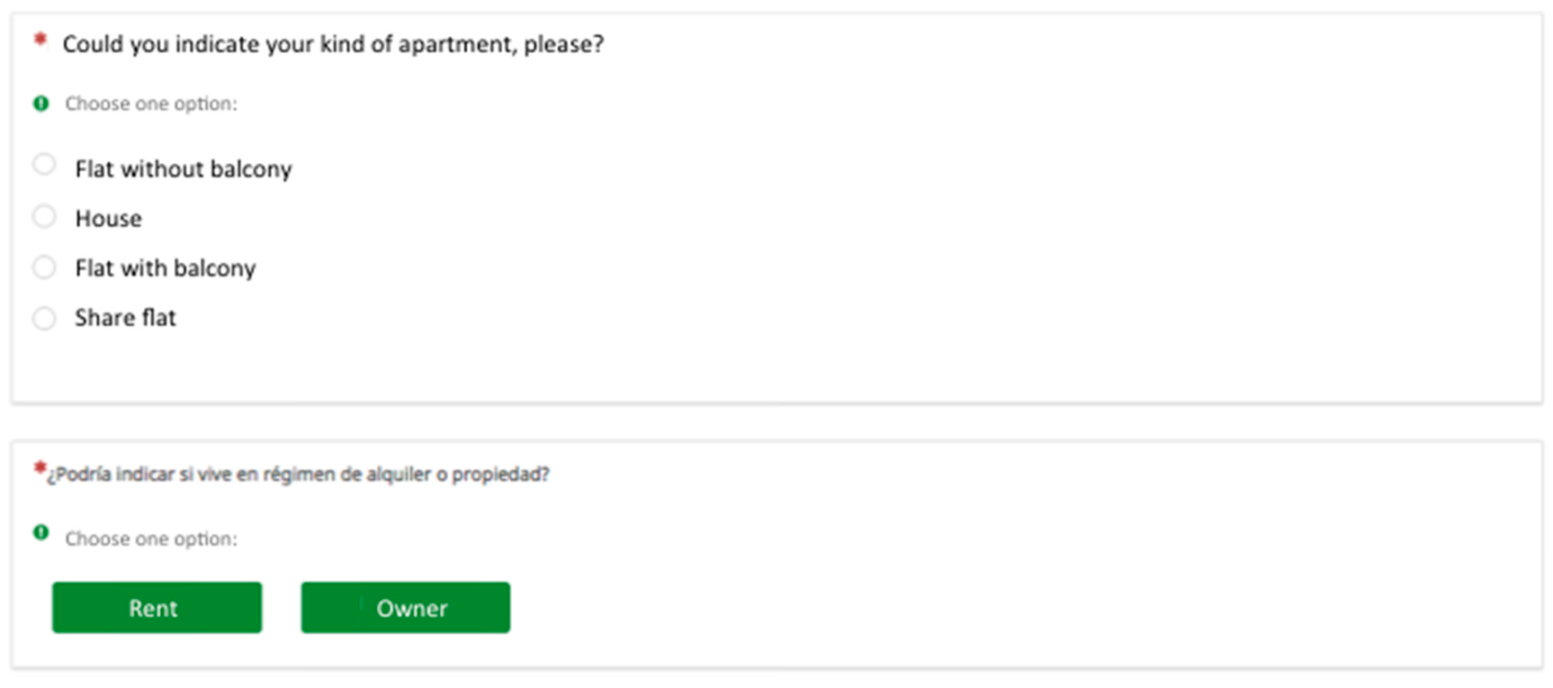
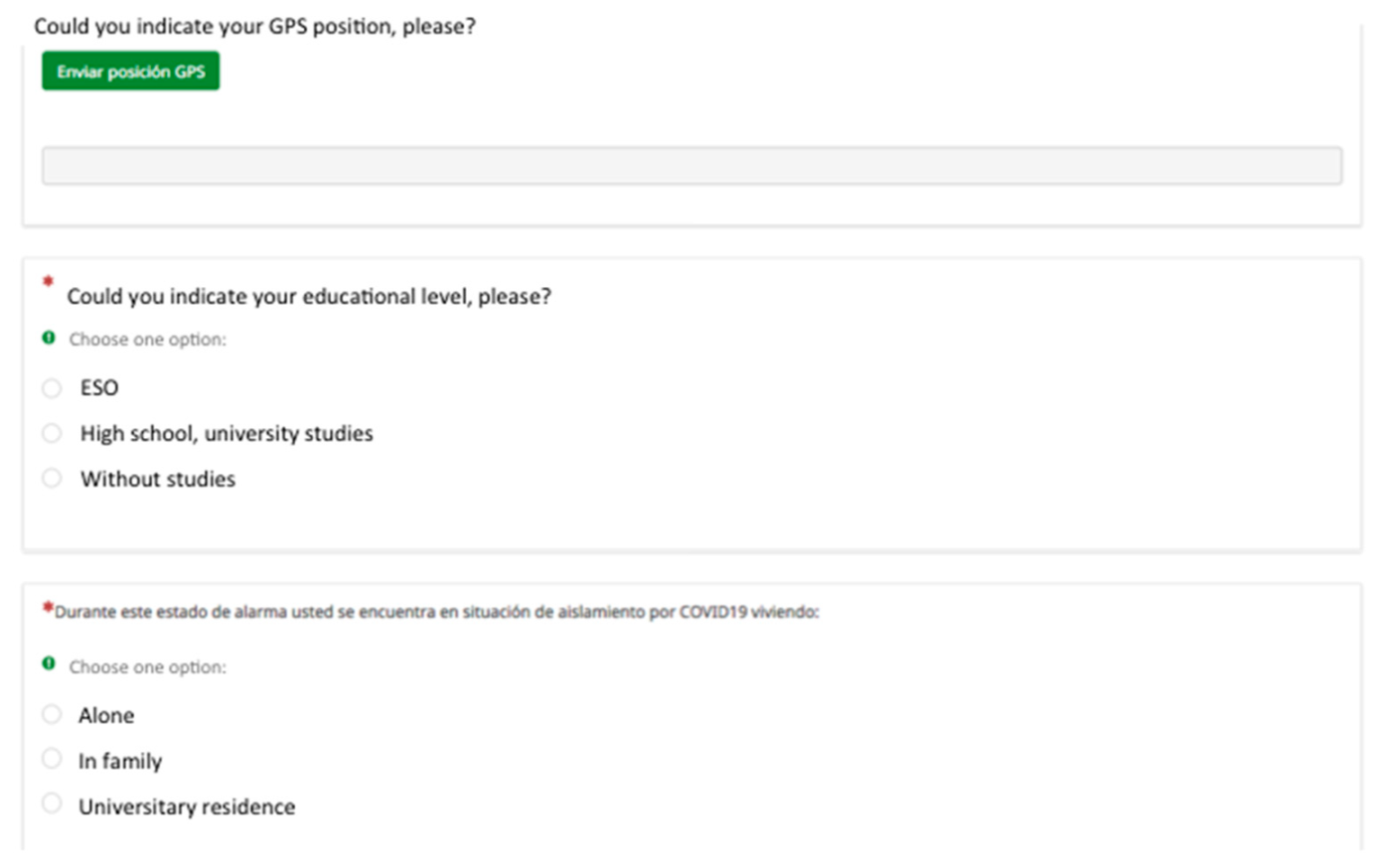
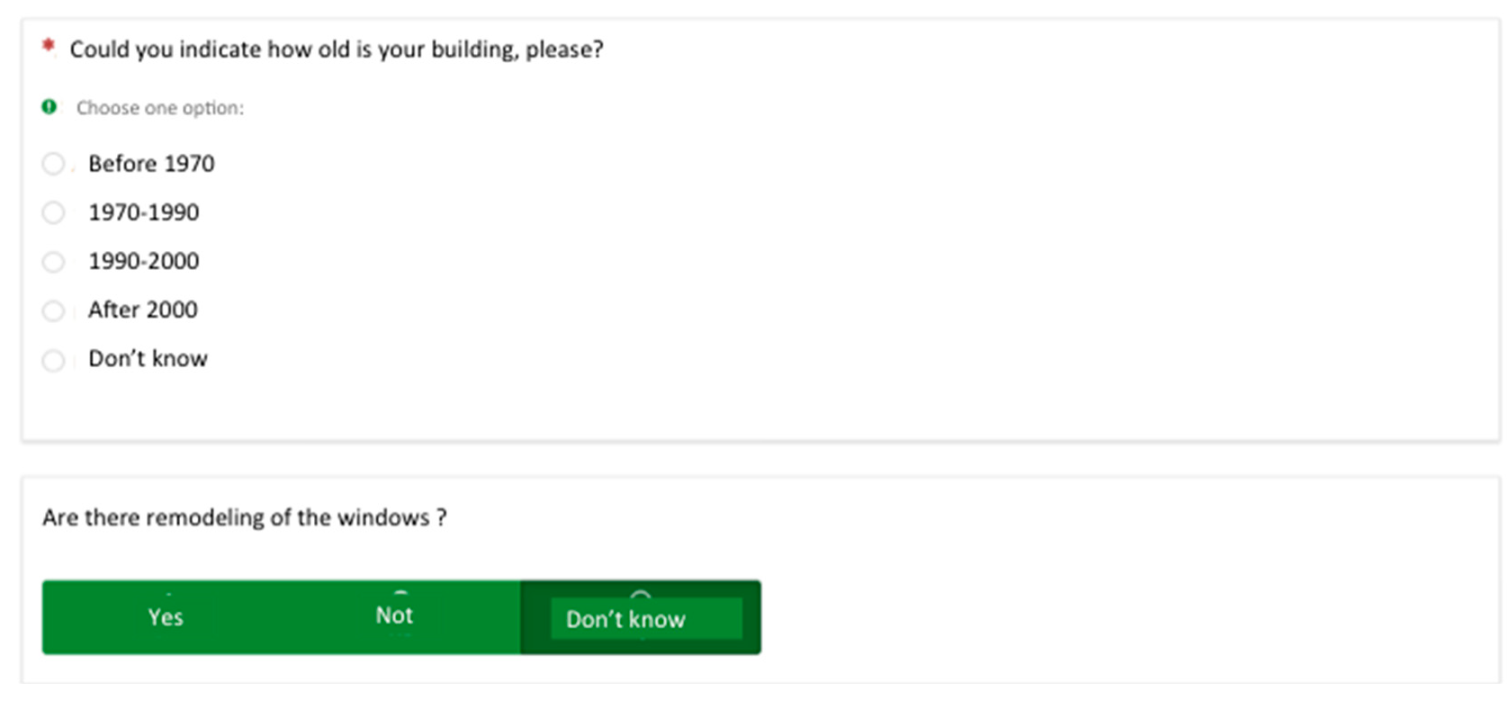

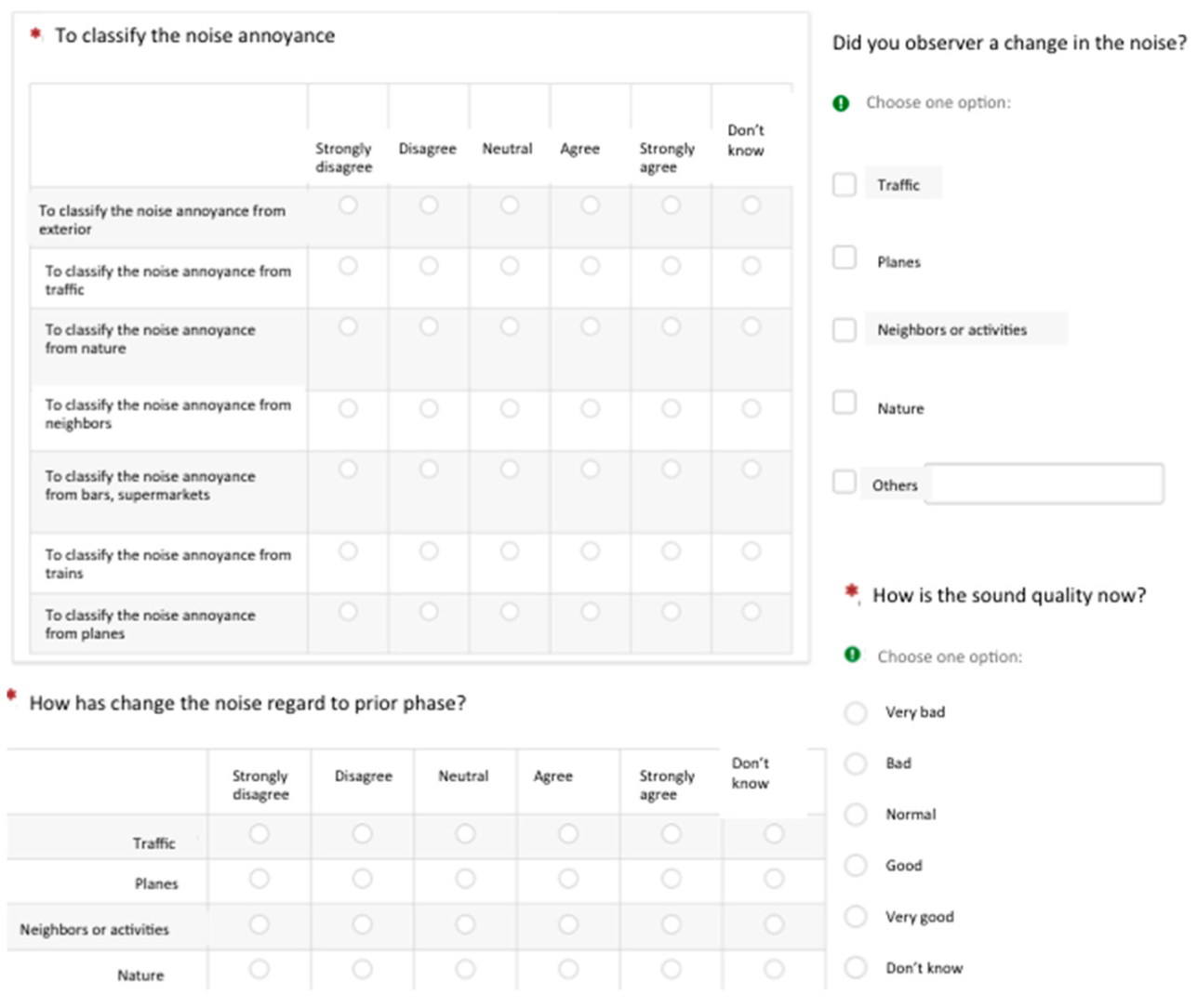

References
- World Health Organization; JCR European Commission. Burden of Disease from Environmental Noise—Quantification of Healthy Life Years Lost in Europe; World Health Organization Regional Office for Europe: Geneva, Switzerland, 2011; p. 126. [Google Scholar]
- Münzel, T.; Gori, T.; Babisch, W.; Basner, M. Cardiovascular Effects of Environmental Noise Exposure. Eur. Heart J. 2014, 35, 829–836. [Google Scholar] [CrossRef]
- Recio, A.; Linares, C.; Banegas, J.R.; Díaz, J. Road Traffic Noise Effects on Cardiovascular, Respiratory, and Metabolic Health: An Integrative Model of Biological Mechanisms. Environ. Res. 2016, 146, 359–370. [Google Scholar] [CrossRef]
- Hahad, O.; Prochaska, J.H.; Daiber, A.; Münzel, T. Environmental Noise-Induced Effects on Stress Hormones, Oxidative Stress, and Vascular Dysfunction: Key Factors in the Relationship between Cerebrocardiovascular and Psychological Disorders. Oxid. Med. Cell. Longev. 2019, 2019, 4623109. [Google Scholar] [CrossRef]
- Kim, A.; Sung, J.H.; Bang, J.-H.; Cho, S.W.; Lee, J.; Sim, C.S. Effects of Self-Reported Sensitivity and Road-Traffic Noise Levels on the Immune System. PLoS ONE 2017, 12, e0187084. [Google Scholar] [CrossRef]
- Thacher, J.D.; Hvidtfeldt, U.A.; Poulsen, A.H.; Raaschou-Nielsen, O.; Ketzel, M.; Brandt, J.; Jensen, S.S.; Overvad, K.; Tjønneland, A.; Münzel, T.; et al. Long-Term Residential Road Traffic Noise and Mortality in a Danish Cohort. Environ. Res. 2020, 187, 109633. [Google Scholar] [CrossRef]
- Steven, S.; Frenis, K.; Kalinovic, S.; Kvandova, M.; Oelze, M.; Helmstädter, J.; Hahad, O.; Filippou, K.; Kus, K.; Trevisan, C.; et al. Exacerbation of Adverse Cardiovascular Effects of Aircraft Noise in an Animal Model of Arterial Hypertension. Redox Biol. 2020, 34, 101515. [Google Scholar] [CrossRef] [PubMed]
- Amoatey, P.; Omidvarbona, H.; Baawain, M.S.; Al-Mayahi, A.; Al-Mamun, A.; Al-Harthy, I. Exposure Assessment to Road Traffic Noise Levels and Health Effects in an Arid Urban Area. Environ. Sci. Pollut. Res. 2020, 27, 35051–35064. [Google Scholar] [CrossRef] [PubMed]
- European Environment Agency. Environmental Noise in Europe, 2020; Publications Office of the European Union: Copenhagen, Denmark, 2020; Volume 22/2019. [Google Scholar]
- Andersen, Z.J.; Jørgensen, J.T.; Elsborg, L.; Lophaven, S.N.; Backalarz, C.; Laursen, J.E.; Pedersen, T.H.; Simonsen, M.K.; Bräuner, E.V.; Lynge, E. Long-term exposure to road traffic noise and incidence of breast cancer: A cohort study. Breast Cancer Res. 2018, 20, 13. [Google Scholar] [CrossRef] [PubMed]
- Sørensen, M.; Ketzel, M.; Overvad, K.; Tjønneland, A.; Raaschou-Nielsen, O. Exposure to Road Traffic and Railway Noise and Postmenopausal Breast Cancer: A Cohort Study. Int. J. Cancer 2014, 134, 2691–2698. [Google Scholar] [CrossRef]
- Hegewald, J.; Schubert, M.; Wagner, M.; Dröge, P.; Prote, U.; Swart, E.; Möhler, U.; Zeeb, H.; Seidler, A. Breast Cancer and Exposure to Aircraft, Road, and Railway-Noise: A Case–Control Study Based on Health Insurance Records. Scand. J. Work Environ. Health 2017, 509–518. [Google Scholar] [CrossRef] [PubMed]
- Orban, E.; McDonald, K.; Sutcliffe, R.; Hoffmann, B.; Fuks, K.B.; Dragano, N.; Viehmann, A.; Erbel, R.; Jöckel, K.-H.; Pundt, N.; et al. Residential Road Traffic Noise and High Depressive Symptoms after Five Years of Follow-up: Results from the Heinz Nixdorf Recall Study. Environ. Health Perspect. 2016, 124, 578–585. [Google Scholar] [CrossRef]
- Beutel, M.E.; Jünger, C.; Klein, E.M.; Wild, P.; Lackner, K.; Blettner, M.; Binder, H.; Michal, M.; Wiltink, J.; Brähler, E.; et al. Noise Annoyance Is Associated with Depression and Anxiety in the General Population—The Contribution of Aircraft Noise. PLoS ONE 2016, 11, e0155357. [Google Scholar] [CrossRef]
- Foraster, M.; Eze, I.C.; Vienneau, D.; Brink, M.; Cajochen, C.; Caviezel, S.; Héritier, H.; Schaffner, E.; Schindler, C.; Wanner, M.; et al. Long-Term Transportation Noise Annoyance Is Associated with Subsequent Lower Levels of Physical Activity. Environ. Int. 2016, 91, 341–349. [Google Scholar] [CrossRef]
- Roswall, N.; Christensen, J.S.; Bidstrup, P.E.; Raaschou-Nielsen, O.; Jensen, S.S.; Tjønneland, A.; Sørensen, M. Associations between Residential Traffic Noise Exposure and Smoking Habits and Alcohol Consumption—A Population-Based Study. Environ. Pollut. 2018, 236, 983–991. [Google Scholar] [CrossRef]
- World Health Organization. Burden of Disease from Ambient Air Pollution for 2012; World Health Organization Regional Office for Europe: Geneva, Switzerland, 2014; p. 130. [Google Scholar]
- Hänninen, O.; Knol, A.B.; Jantunen, M.; Lim, T.-A.; Conrad, A.; Rappolder, M.; Carrer, P.; Fanetti, A.-C.; Kim, R.; Buekers, J.; et al. Environmental Burden of Disease in Europe: Assessing Nine Risk Factors in Six Countries. Environ. Health Perspect. 2014, 122, 439–446. [Google Scholar] [CrossRef] [PubMed]
- Aulsebrook, L.C.; Bertram, M.G.; Martin, J.M.; Aulsebrook, A.E.; Brodin, T.; Evans, J.P.; Hall, M.D.; O’Bryan, M.K.; Pask, A.J.; Tyler, C.R.; et al. Reproduction in a Polluted World: Implications for Wildlife. Reproduction 2020, 160, R13–R23. [Google Scholar] [CrossRef] [PubMed]
- Bar, H. COVID-19 Lockdown: Animal Life, Ecosystem and Atmospheric Environment. Environ. Dev. Sustain. 2020. [Google Scholar] [CrossRef]
- Robinson, D.L. Air Pollution in Australia: Review of Costs, Sources and Potential Solutions. Health Promot. J. Austr. 2005, 16, 213–220. [Google Scholar] [CrossRef] [PubMed]
- Vadrevu, K.P.; Eaturu, A.; Biswas, S.; Lasko, K.; Sahu, S.; Garg, J.K.; Justice, C. Spatial and Temporal Variations of Air Pollution over 41 Cities of India during the COVID-19 Lockdown Period. Sci. Rep. 2020, 10, 16574. [Google Scholar] [CrossRef]
- Lolli, S.; Chen, Y.-C.; Wang, S.-H.; Vivone, G. Impact of Meteorological Conditions and Air Pollution on COVID-19 Pandemic Transmission in Italy. Sci. Rep. 2020, 10, 16213. [Google Scholar] [CrossRef]
- Pandey, M.; Chalk, W. Lockdown: ‘Noisy Neighbours Are Ruining My Life’. BBC News, 12 May 2020; p. 3. [Google Scholar]
- Gupta, S. Air Pollution in Northern India Has Hit a 20-Year Low, NASA Report Says. CNN News, 23 April 2020; p. 5. [Google Scholar]
- ESA. Air Pollution in a Post-COVID-19 World; European Space Agency: Paris, France, 2020; p. 5. [Google Scholar]
- Aletta, F.; Oberman, T.; Mitchell, A.; Tong, H.; Kang, J. Assessing the Changing Urban Sound Environment during the COVID-19 Lockdown Period Using Short-Term Acoustic Measurements. Noise Mapp. 2020, 7, 123–134. [Google Scholar] [CrossRef]
- Arora, S.; Bhaukhandi, K.D.; Mishra, P.K. Coronavirus Lockdown Helped the Environment to Bounce Back. Sci. Total Environ. 2020, 742, 140573. [Google Scholar] [CrossRef]
- Rumpler, R.; Venkataraman, S.; Göransson, P. An Observation of the Impact of CoViD-19 Recommendation Measures Monitored through Urban Noise Levels in Central Stockholm, Sweden. Sustain. Cities Soc. 2020, 63, 102469. [Google Scholar] [CrossRef] [PubMed]
- Asensio, C.; Pavón, I.; de Arcas, G. Changes in Noise Levels in the City of Madrid during COVID-19 Lockdown in 2020. J. Acoust. Soc. Am. 2020, 148, 1748. [Google Scholar] [CrossRef] [PubMed]
- Royal borough of Greenwich Noise during the Coronavirus (COVID-19) Pandemic. Available online: https://www.royalgreenwich.gov.uk/info/200205/pollution_and_noise/656/noise_complaints (accessed on 1 November 2020).
- Poli, P.; Boaga, J.; Molinari, I.; Cascone, V.; Boschi, L. The 2020 Coronavirus Lockdown and Seismic Monitoring of Anthropic Activities in Northern Italy. Sci. Rep. 2020, 10, 9404. [Google Scholar] [CrossRef] [PubMed]
- Rutz, C.; Loretto, M.-C.; Bates, A.E.; Davidson, S.C.; Duarte, C.M.; Jetz, W.; Johnson, M.; Kato, A.; Kays, R.; Mueller, T.; et al. COVID-19 Lockdown Allows Researchers to Quantify the Effects of Human Activity on Wildlife. Nat. Ecol. Evol. 2020, 4, 1156–1159. [Google Scholar] [CrossRef] [PubMed]
- Alston, W.P. Empirical arguments for the reliability of sp. In The Reliability of Sense Perception; Cornell University Press: Ithaca, NY, USA, 1996; Chapter 4; pp. 60–119. [Google Scholar]
- Bodur, S.; Filiz, E. Validity and Reliability of Turkish Version of “Hospital Survey on Patient Safety Culture” and Perception of Patient Safety in Public Hospitals in Turkey. BMC Health Serv. Res. 2010, 10, 28. [Google Scholar] [CrossRef]
- Gao, Y.; Gonzalez, V.A.; Yiu, T.W. The Effectiveness of Traditional Tools and Computer-Aided Technologies for Health and Safety Training in the Construction Sector: A Systematic Review. Comput. Educ. 2019, 138, 101–115. [Google Scholar] [CrossRef]
- Nie, R.; Han, Y.; Xu, J.; Huang, Q.; Mao, J. Illness Perception, Risk Perception and Health Promotion Self-Care Behaviors among Chinese Patient with Type 2 Diabetes: A Cross-Sectional Survey. Appl. Nurs. Res. 2018, 39, 89–96. [Google Scholar] [CrossRef] [PubMed]
- Han, X.; Wang, J.; Zhang, M.; Wang, X. Using Social Media to Mine and Analyze Public Opinion Related to COVID-19 in China. Int. J. Environ. Res. Public Health 2020, 17, 2788. [Google Scholar] [CrossRef]
- Gupta, S.; Raghuwanshi, G.S.; Chanda, A. Effect of Weather on COVID-19 Spread in the US: A Prediction Model for India in 2020. Sci. Total Environ. 2020, 728, 138860. [Google Scholar] [CrossRef]
- Redel-Macías, M. Ruido y Covid-19; Radio Interview Onda Mezquita: Cordoba, Spain, 2020. Available online: https://www.ahoracordoba.es (accessed on 12 December 2020).
- Zwicker, E.; Fastl, H. Psychoacoustics: Facts and Models; Springer: Berlin, Germany, 2007; Volume 12, ISBN 978-3-540-65063-8. [Google Scholar]
- Directive 2002/49/EC of the European Parliament and of the Council of 25 June 2002 Relating to the Assessment and Management of Environmental Noise; European Parliament: Brussel, Belgium, 2002; Volume 189, pp. 12–25.
- Medina, M.A. Why You Shouldn’t Be Afraid to Take Public Transportation amid the Covid-19 Pandemic. El País, 15 September 2020; p. 7. [Google Scholar]
- García-Esquinas, E.; Ortolá, R.; Gine-Vázquez, I.; Carnicero, J.A.; Mañas, A.; Lara, E.; Alvarez-Bustos, A.; Vicente-Rodriguez, G.; Sotos-Prieto, M.; Olaya, B.; et al. Changes in Health Behaviors, Mental and Physical Health among Older Adults under Severe Lockdown Restrictions during the COVID-19 Pandemic in Spain. medRxiv 2021. [Google Scholar] [CrossRef]
- McGhan, G.E.; Ludlow, N.C.; Rathert, C.; McCaughey, D. Variations in Workplace Safety Climate Perceptions and Outcomes Across Healthcare Provider Positions. J. Healthc. Manag. 2020, 65, 202–215. [Google Scholar] [PubMed]
- De Meester, K.; Van Bogaert, P.; Clarke, S.P.; Bossaert, L. In-Hospital Mortality after Serious Adverse Events on Medical and Surgical Nursing Units: A Mixed Methods Study. J. Clin. Nurs. 2013, 22, 2308–2317. [Google Scholar] [CrossRef] [PubMed]
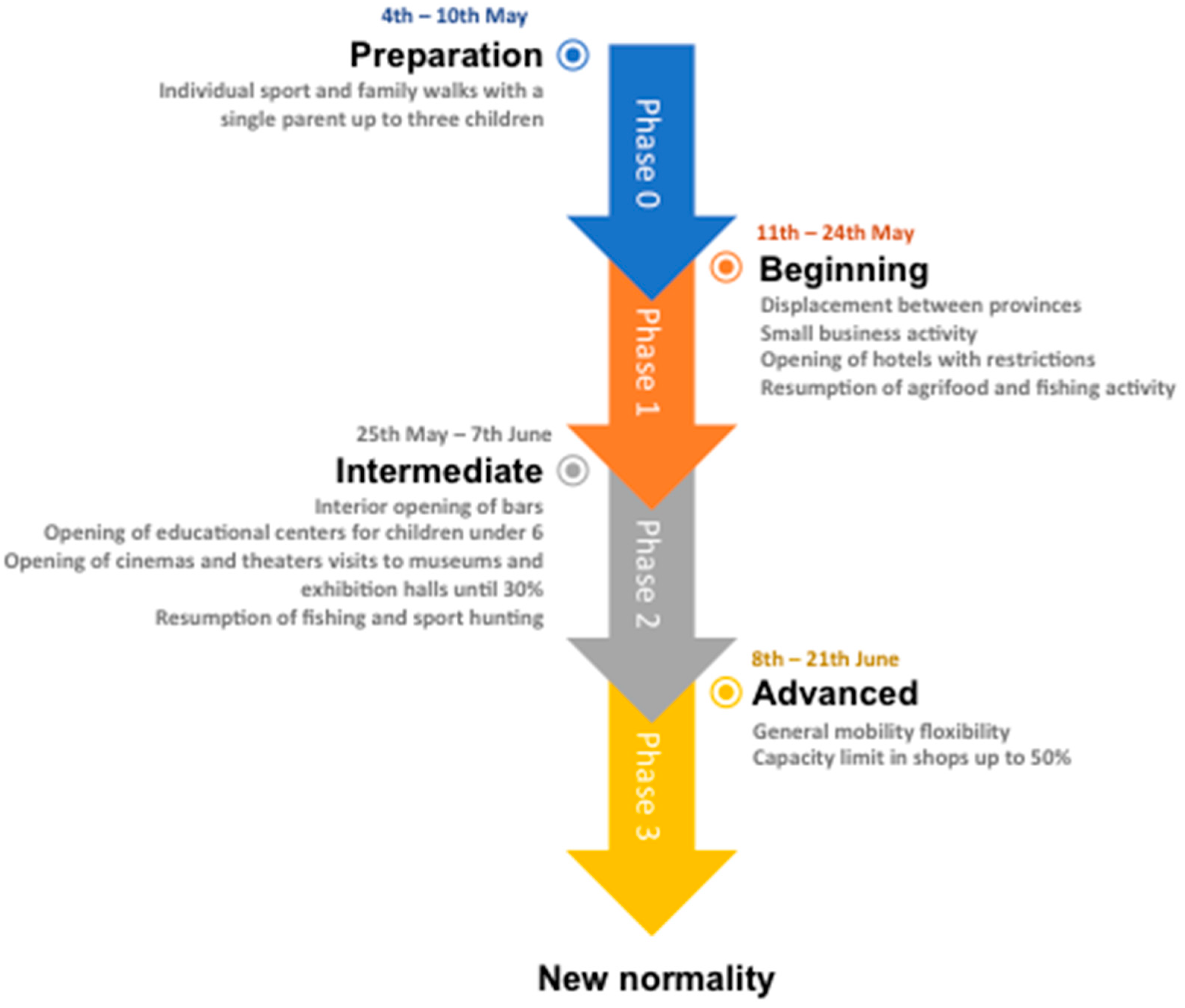

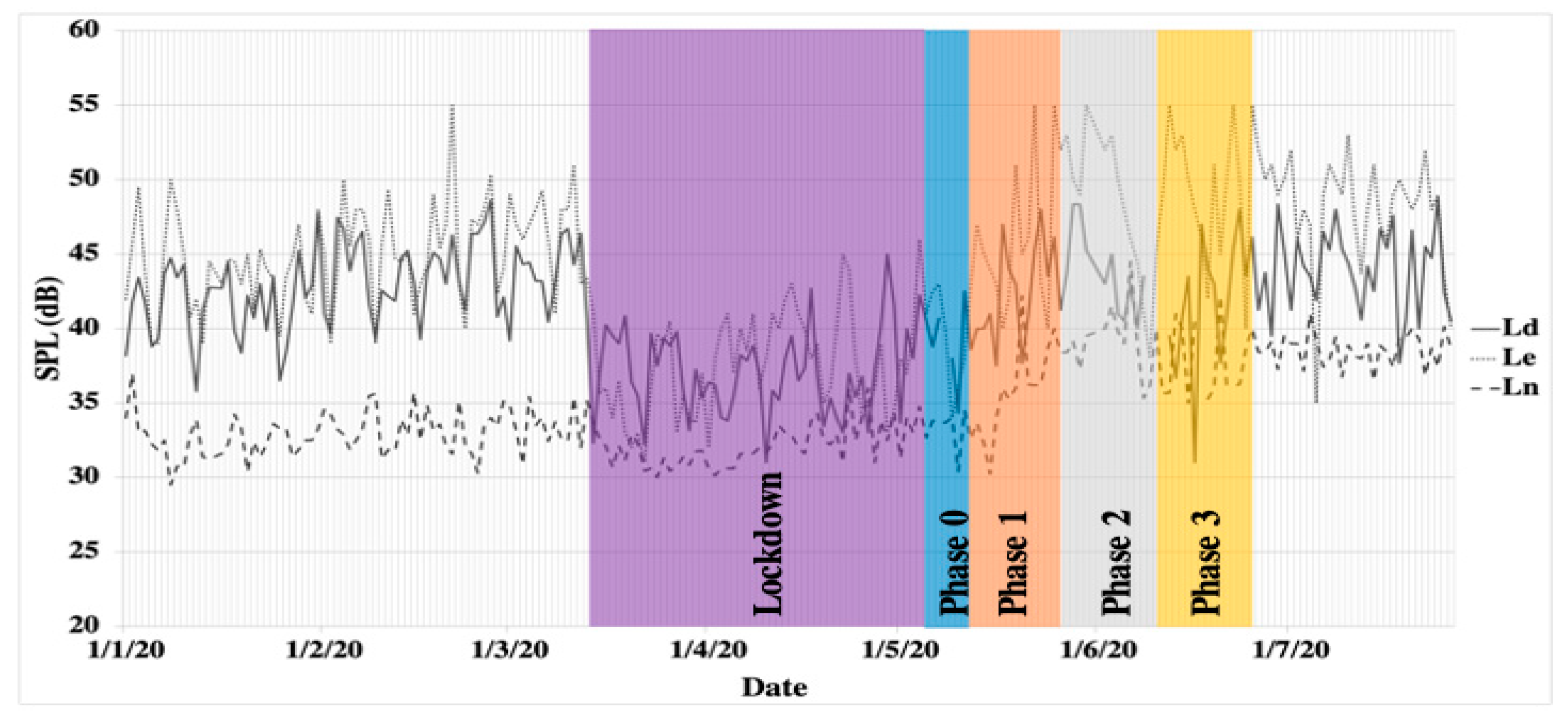
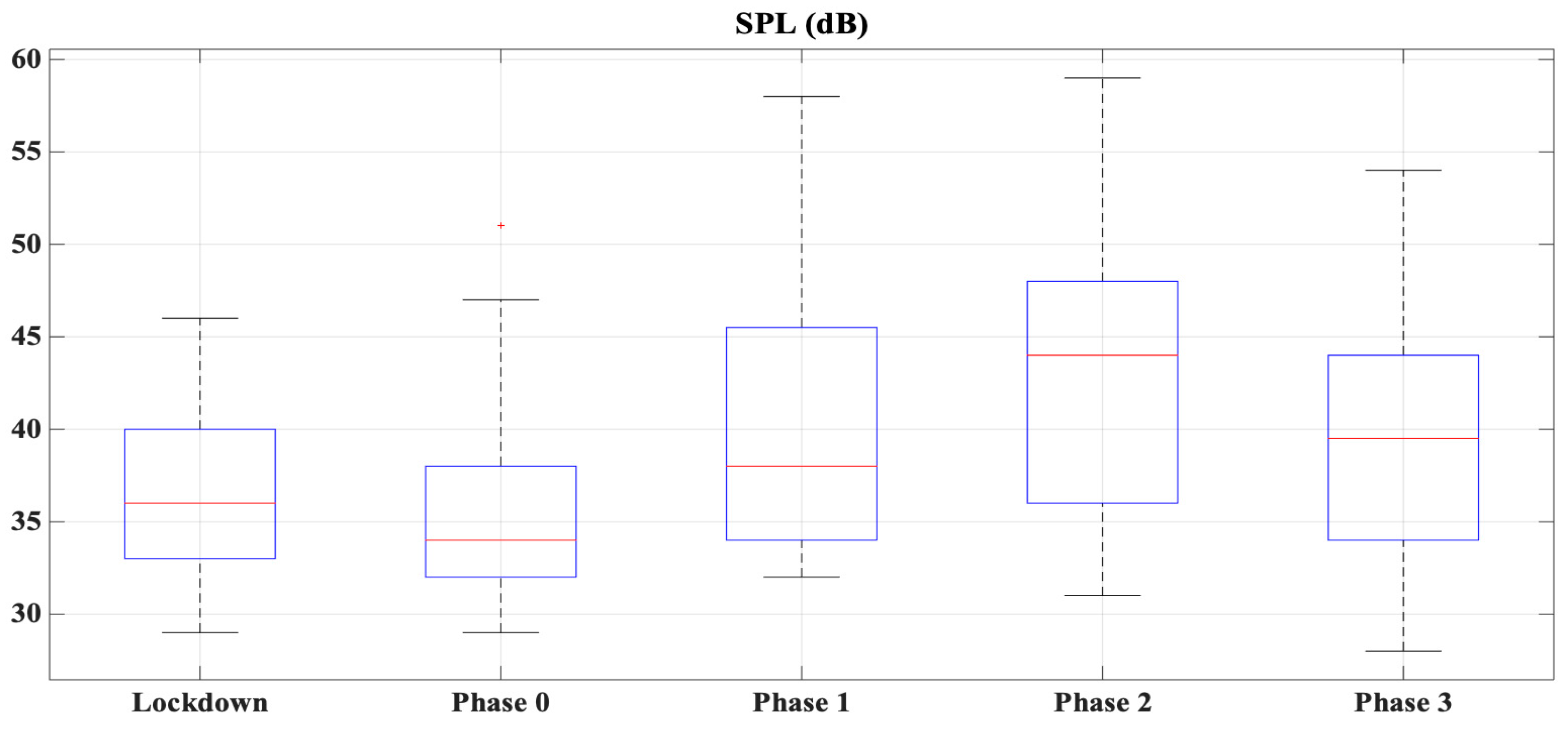


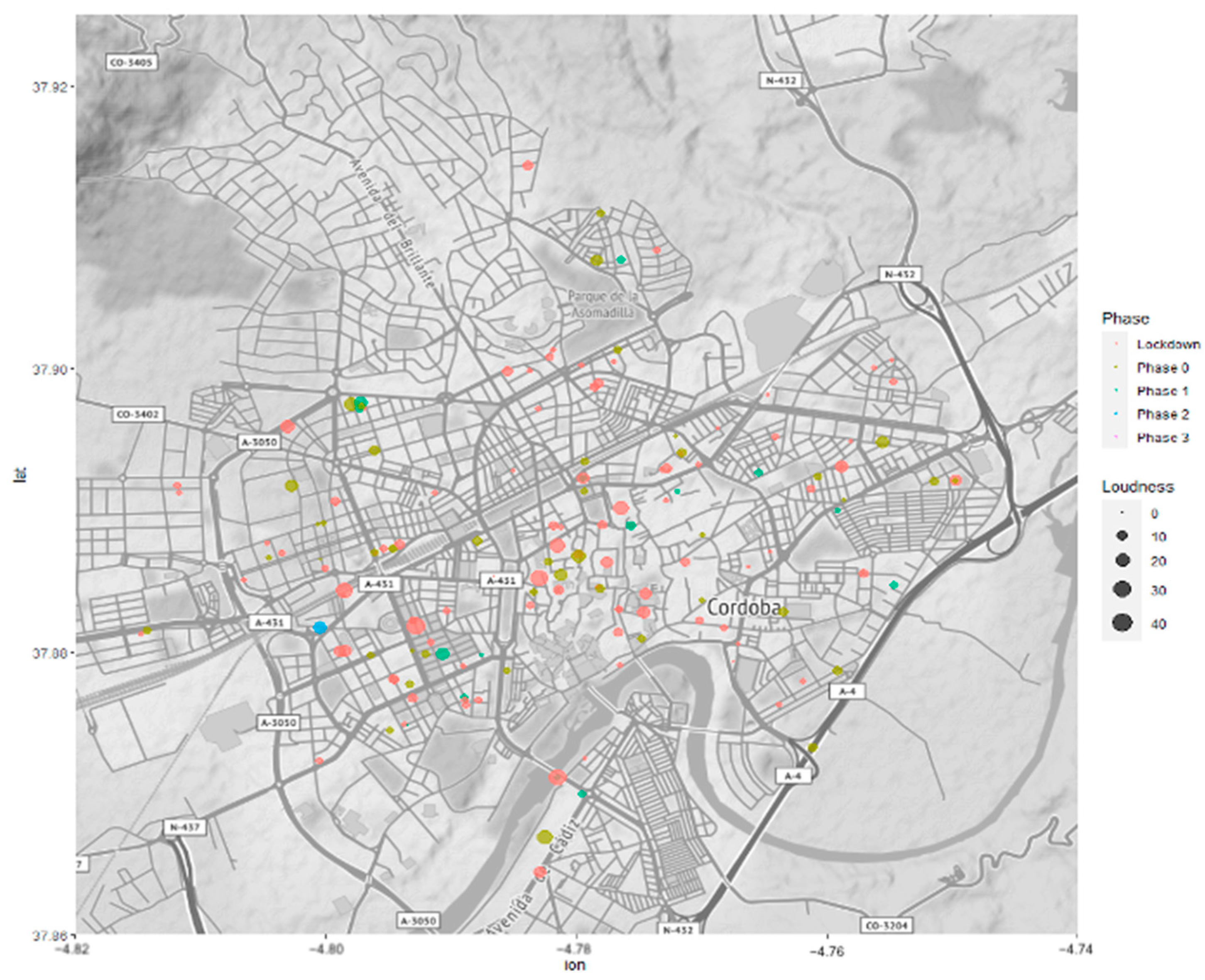


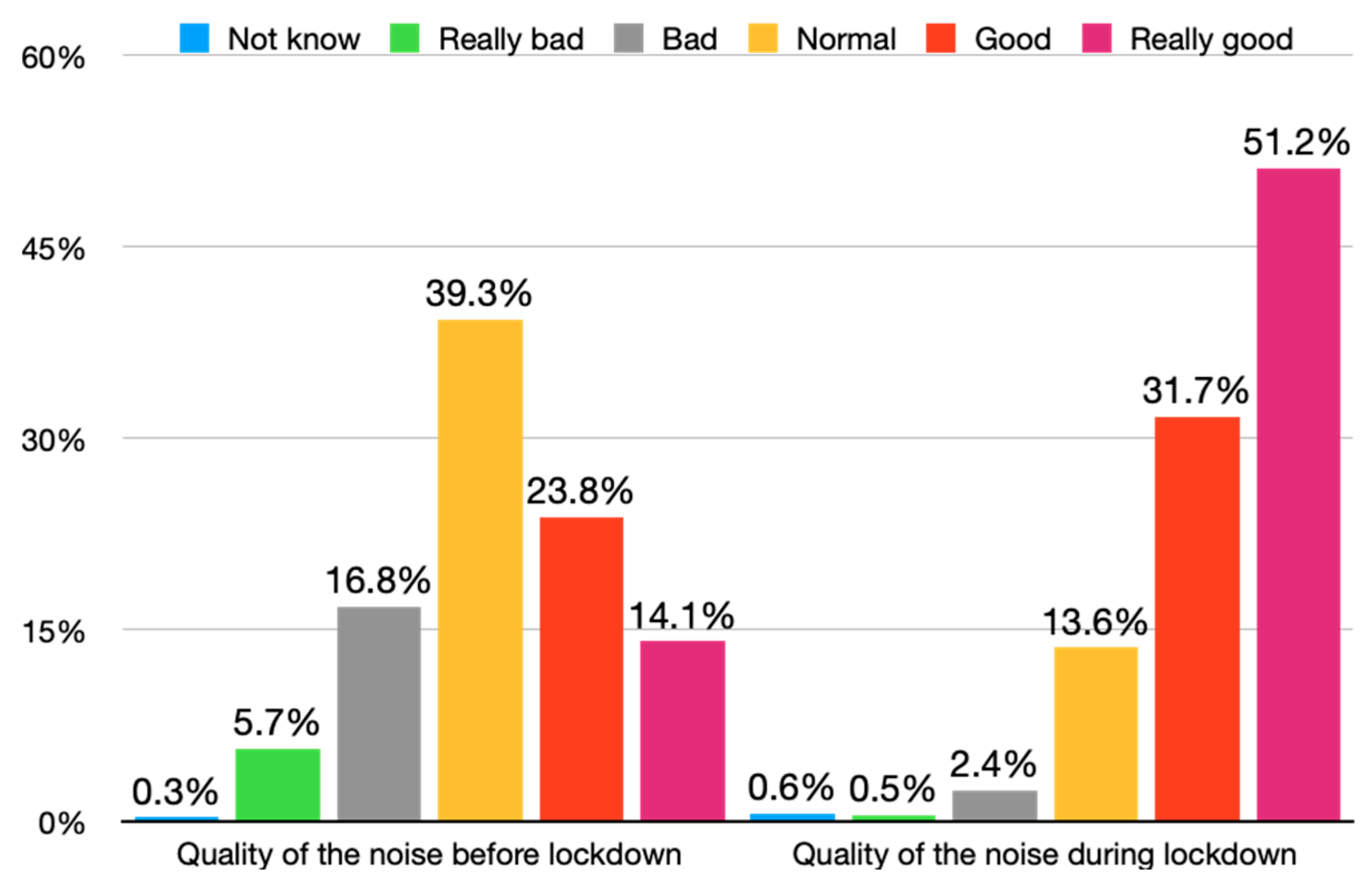
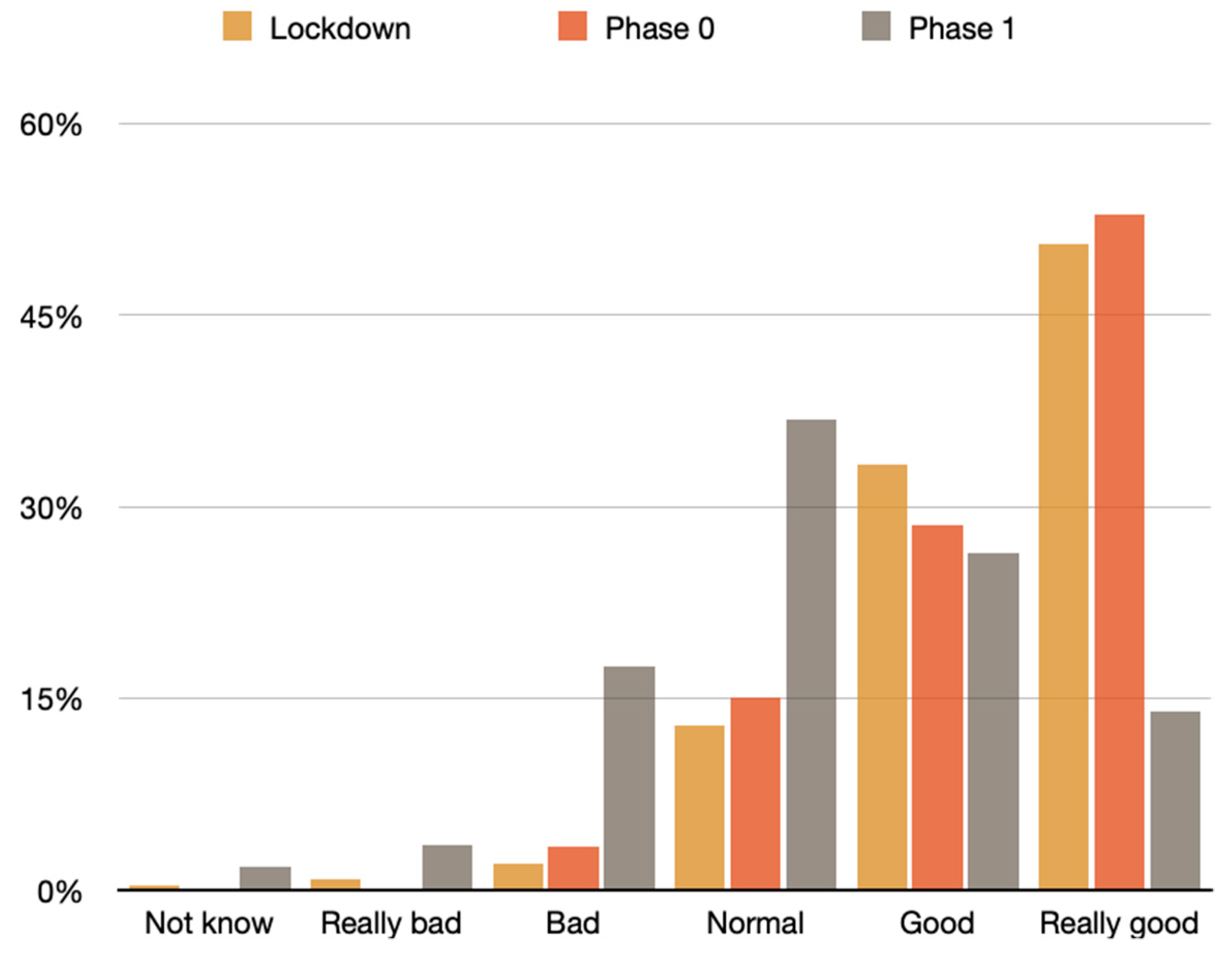
| Age | Gender | Educational Level | Cohabitants | Modifications | Ownership | Kind of Property | Year of Construction | |
|---|---|---|---|---|---|---|---|---|
| p-Value | p-Value | p-Value | p-Value | p-Value | p-Value | p-Value | p-Value | |
| Age | ||||||||
| Gender | <0.05 | |||||||
| Educational level | >0.05 | >0.05 | ||||||
| Cohabitants | <0.01 | >0.05 | >0.05 | |||||
| Modifications | <0.001 | >0.05 | <0.01 | 0.05 | ||||
| Ownership | <0.001 | >0.05 | >0.05 | <0.001 | <0.001 | |||
| Kind of Property | >0.05 | >0.05 | <0.05 | <0.001 | <0.001 | <0.001 | ||
| Year of construction | >0.05 | >0.05 | >0.05 | >0.05 | <0.001 | <0.001 | <0.001 | |
| Quality of the noise before lockdown | >0.05 | >0.05 | >0.05 | >0.05 | <0.001 | <0.001 | <0.001 | <0.001 |
| Annoyance of Noise from: | Age | Gender | Educational Level | Cohabitants | Modifications | Ownership | Kind of Property | Year of Construction | Sound Quality |
|---|---|---|---|---|---|---|---|---|---|
| Outside | −0.08 | 0.03 | 0.05 | −0.02 | −0.02 | −0.16 *** | 0.24 *** | −0.18 *** | −0.65 *** |
| Traffic | −0.004 | 0.03 | 0.06 | −0.03 | 0.04 | −0.15 ** | 0.23 ** | −0.12 ** | −0.55 *** |
| Nature | 0.00 | −0.16 ** | −0.16 ** | −0.02 | −0.05 | 0.001 | −0.12 ** | 0.001 | 0.07 |
| Neighbors | −0.13 ** | −0.02 | −0.05 | −0.01 | −0.06 | −0.09 * | 0.20 ** | −0.072 | −0.28 ** |
| Bars, supermarkets and other business | −0.02 | −0.03 | 0.06 | 0.01 | 0.02 | −0.197 ** | 0.280 ** | −0.176 ** | −0.43 ** |
| Trains | 0.02 | 0.04 | −0.04 | −0.06 | −0.05 | −0.06 | 0.014 | 0.07 | −0.07 |
| Airplanes | 0.78 | 0.21 | 0.821 | 0.44 | 0.357 | −0.07 | 0.114 | 0.38 | 0.02 |
| Annoyance of Noise from: | Age | Gender | Educational Level | Cohabitants | Modifications | Ownership | Property | Year of Construction |
|---|---|---|---|---|---|---|---|---|
| Outside | −0.110 ** | 0.047 | −0.144 ** | 0.014 | −0.06 | −0.080 | 0.100 ** | −0.090 * |
| Traffic | 0.001 | 0.061 | −0.024 | 0.010 | 0.024 | −0.100 | 0.070 | −0.070 |
| Nature | −0.070 | −0.190 ** | −0.150 ** | −0.040 | −0.095 | −0.11 ** | 0.240 *** | −0.090 * |
| Neighbors | −0.070 | −0.193 ** | −0.150 ** | −0.070 | −0.020 | 0.070 | −0.130 *** | −0.001 |
| Bars, supermarkets and other business | 0.06 | −0.005 | −0.056 | 0.070 | 0.020 | −0.140** | 0.150 *** | −0.140 ** |
| Trains | 0.070 | 0.042 | −0.061 | −0.030 | 0.020 | −0.050 | −0.020 | −0.050 |
| Airplanes | −0.002 | 0.019 | −0.064 | 0.020 | −0.070 | −0.030 | −0.050 | −0.030 |
| Difference between phase 0 and lockdown | −0.110 ** | 0.092 * | 0.140 ** | 0.050 | 0.040 | −0.041 | 0.119** | −0.042 |
Publisher’s Note: MDPI stays neutral with regard to jurisdictional claims in published maps and institutional affiliations. |
© 2021 by the authors. Licensee MDPI, Basel, Switzerland. This article is an open access article distributed under the terms and conditions of the Creative Commons Attribution (CC BY) license (http://creativecommons.org/licenses/by/4.0/).
Share and Cite
Redel-Macías, M.D.; Aparicio-Martinez, P.; Pinzi, S.; Arezes, P.; Cubero-Atienza, A.J. Monitoring Sound and Its Perception during the Lockdown and De-Escalation of COVID-19 Pandemic: A Spanish Study. Int. J. Environ. Res. Public Health 2021, 18, 3392. https://doi.org/10.3390/ijerph18073392
Redel-Macías MD, Aparicio-Martinez P, Pinzi S, Arezes P, Cubero-Atienza AJ. Monitoring Sound and Its Perception during the Lockdown and De-Escalation of COVID-19 Pandemic: A Spanish Study. International Journal of Environmental Research and Public Health. 2021; 18(7):3392. https://doi.org/10.3390/ijerph18073392
Chicago/Turabian StyleRedel-Macías, María Dolores, Pilar Aparicio-Martinez, Sara Pinzi, Pedro Arezes, and Antonio José Cubero-Atienza. 2021. "Monitoring Sound and Its Perception during the Lockdown and De-Escalation of COVID-19 Pandemic: A Spanish Study" International Journal of Environmental Research and Public Health 18, no. 7: 3392. https://doi.org/10.3390/ijerph18073392
APA StyleRedel-Macías, M. D., Aparicio-Martinez, P., Pinzi, S., Arezes, P., & Cubero-Atienza, A. J. (2021). Monitoring Sound and Its Perception during the Lockdown and De-Escalation of COVID-19 Pandemic: A Spanish Study. International Journal of Environmental Research and Public Health, 18(7), 3392. https://doi.org/10.3390/ijerph18073392








